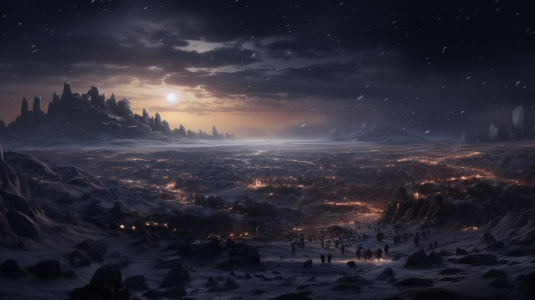The Ice Age
Cause & Effect
The Ice Age was the direct consequence of The Cataclysm at the end of the War of Ascension during the 2nd World.
After the eruption that shook the world to its core, and after the rains of rock and fire ceased, the world was shrouded in a thick layer of dust and ash. The skies turned gray and bleak, temperatures dropped drastically, and frost crept across the land.
Unlike The Cataclysm, which was sudden and devastating, the Ice Age settled in slowly. Over weeks, the frost advanced, turning much of the north into an icy wasteland. Yet, while it cursed the north, it blessed the south: the arid deserts cooled, and rainfall came for the first time in centuries, breathing new life into otherwise barren regions. This climatic shift ushered in a golden age for the southern peoples.
However, as with all things, this too passed. The Ice Age lasted for hundreds of years but eventually receded. The north thawed, giving its cultures a second wind and ushering in a renaissance. Meanwhile, the south suffered as lush tropical forests dried up and shrank, leaving flourishing civilizations devastated.
Realms of Kleriel
In the Realms of Kleriel, the situation was particularly dire. The old Kleriel Imperium , once a unifying force across the continent, had collapsed. Its constituent realms, Elven cultures all, fragmented and scrambled for survival, often turning on one another in desperate bids for dominance. The Cataclysm had deprived the world of its Arcane energies, a loss that cast Elven society into turmoil. Their reliance on magic for warfare, infrastructure, and even daily life left them vulnerable in this dark era.
To make matters worse, Elvendom faced relentless attacks along its northern borders. As ice sheets crept southward, the primitive Humans of the far north migrated en masse in search of survival. This period, known as The Great Migrations , saw the Elves pushed out of regions of Arboria , Azhkar, and Sahadra. With them, the Humans also brought the rapid spread of the Kambrona Plague.
The Dwarves, long dwellers of the Underworld, were also forced above ground to survive. The earth trembled as their vast tunnel systems collapsed or flooded with magma and water. Thrust into an unfamiliar and hostile world, they faced potential enemies on all sides.
This era in the Realms of Kleriel is remembered for its strife: endless conflicts, power struggles, migrations, and near-extinctions.
Realms of Serenjara
On the southern continent of Serenjara, the effects of the Ice Age were markedly different. Like the rest of the world, its people watched in awe as fire rained from the sky and the earth quaked during The Cataclysm . Yet for Serenjara, the Ice Age brought blessings.
Temperatures fell, cooling the harsh deserts. For the first time in history, rainfall blessed the scorched drylands. Over time, palm trees and shrubbery spread from the banks of the Zahara and Tamara rivers, as well as the oases that dotted the landscape, growing into a vast rainforest that covered much of the Merivian region.
During these centuries of abundance, the Orcs of Merivia experienced a golden age. They thrived in their lush rainforest, which they called Orssirai, or "Oasis of the Orcs." However, prosperity brought conflict. The jealous Krall people of Blackrock launched invasions into Orssirai, which only served to unite the Orc kingdoms into a powerful empire. The Orcs pushed the Krall out and secured their place as one of the dominant civilizations of the early 3rd World.
The Orssirai Empire ruled over Merivia and the Orkalah Desert for centuries. However, as the Ice Age receded, the skies cleared, rains diminished, and the lands dried once more. The once-thriving Orc population began to starve, turning to infighting as their civilization crumbled. Reduced to scattered nomadic clans, the Orcs struggled to survive. The last vestige of their empire held out in the Zahamara Delta, where the two great rivers converged. This once-vibrant cultural hub had become a fortress under constant siege by rival factions.
As the Orkalah Desert reclaimed its territory, the remaining Orcs faced stark choices: fight over the few remaining scraps of fertile land or flee to foreign lands. Those who stayed lived as nomads, while those who left were shunned as outlanders, their dark appearance and alien culture marking them as outsiders. Forced to live on the fringes of other civilizations, they retained their clan societies.
Yet not all was lost. Some Orcs discovered unspoiled land on the Tallawa Isles, a lush and fertile archipelago. Here, they found refuge and built new roots, establishing fresh kingdoms and beginning anew.




Comments